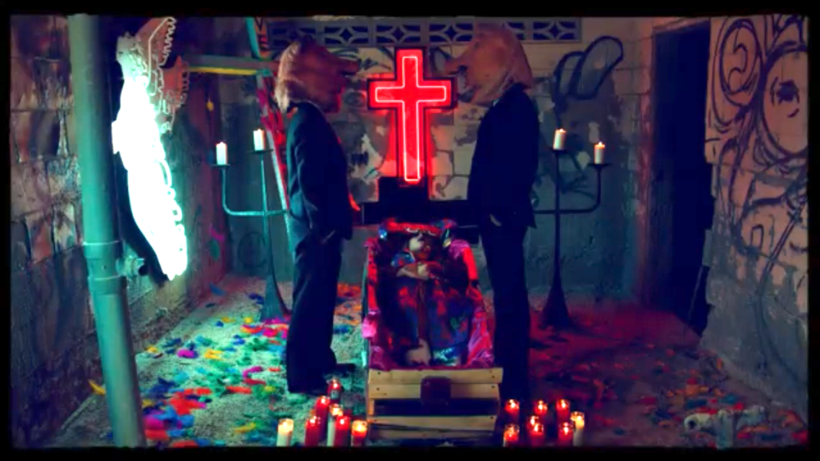The Gospel According to Kesha
Kesha's 2017 single, "Praying," delivers a message that is both utterly queer and profoundly Christian, writes William Stell.
First, a confession: I have long disliked Kesha’s work.
Call me a bad gay, but “TiK ToK” and “Crazy Kids” never did it for me. Catchy as her music was, the lyrics felt irredeemably vacuous, and I walked away from just about every song with a whiff of rich white girl entitlement. For years, I have rolled my eyes at the mere mention of her name.
Then I heard “Praying.”
When she released the song as the first single off her album, Rainbow (which came out a year ago this month), it was also the first original song that the pop star had released in five years—and in order to properly appreciate it, you have to know why it’s been so long. Beginning in 2013, Kesha became embroiled in a legal dispute with her former producer, Lukasz “Dr. Luke” Gottwald, who signed her to his label, Kemosabe Records, over a decade ago. In 2014, after checking herself into rehab, Kesha sued Dr. Luke for alleged sexual assault and battery, gender violence, emotional abuse, and more. Just last year, the dispute came to a disturbing end when the New York Supreme Court rejected all of Kesha’s claims. Addressed both to Dr. Luke and to God, “Praying” is a response to the pain that Kesha endured in the years leading up this new album.
Like much of her past output, this song and the accompanying music video contain plenty of queer imagery, with colors and rainbows in abundance. But much less characteristic for the openly bisexual artist, “Praying” is replete with religious language and symbolism—crosses, Bible verses, and numerous other references to Christian texts and traditions. Far from conflicting with each other, these two themes of queerness and Christianity are variously connected in the song and video (for example, a rainbow-colored cross with the words “Love” and “Universal” written on it).
"Praying" pronounces hope that bad people will eventually heal, flourish, find peace. Rather than wishing for their deserved damnation, the song wishes them undeserved blessing.
But the connection runs much deeper than this overt symbolism. In Kesha’s posture towards her oppressor—a praying posture, maybe even a forgiving posture—“Praying” subtly fuses queerness and Christianity in a unique message that packs quite the punch.
The opening shot of the music video shows Kesha lying down in a long wooden box underneath a neon red cross. She is flanked by two men wearing business suits and lifelike pig’s heads, looking down on and drooling over her motionless body. The box in which she lies appears to be part-bed, part-coffin, part-trough—and thus, part-manger. Before singing, Kesha speaks a modernized psalm of lament: “Why have I been abandoned by everyone and everything I’ve ever known? … What is the lesson? What is the point? God, give me a sign, or I have to give up. I can’t do this anymore. Please just let me die.”
The opening shot of "Praying." (Vevo)
The gravity and intensity continue throughout the song: glimpses of Kesha shipwrecked, trapped in fishing nets, praying and screaming through tears of darkened blood underneath the same neon red cross. But we also can see a near-constant panoply of bright rainbow colors—a seeming dissonance that evokes queerness’s time-honored tradition of parading through its suffering. (Christianity has its own parallel of this tradition, by the way: proclaiming victory through a crucifixion.)
The most striking form that queerness takes in “Praying,” though, is not in colors or rainbows, but in the words of the song’s chorus:
I hope you’re somewhere praying, praying / I hope your soul is changing, changing / I hope you find your peace / falling on your knees, praying
Among other things, queerness is subversive engagement with binary systems, so this chorus is rightly called “queer,” in that it works to undermine a common moral binary: good things should happen to good people, and bad things should happen to bad people. This is one of those binaries that relatively few people want to disrupt—and for good reason.
But the chorus of “Praying” does precisely that. It pronounces hope that the bad people will eventually heal, flourish, find peace. Rather than wishing for their deserved damnation, the song wishes them undeserved blessing. This is, in fact, one way of defining forgiveness: desiring good things for people who have done bad things. And by this definition, forgiveness is profoundly queer.
It is not a forgiveness that downplays abuse, as Kesha is forthright in naming and revealing the severity of her pain. It is not a forgiveness that overlooks injustice, as the song clearly indicts Kesha’s abuser and never revokes or reduces this indictment. It is not a forgiveness that pressures the survivor into a superficial reconciliation, as the businessmen never take off their pig heads, and there is no hint that the survivor might make friends with the swine. Lastly, it is not a forgiveness that lets someone off the hook for their evil actions, as Kesha clearly conveys that her abuser must repent, that his soul must change, that he must fall on his knees. Only then, when he has truly repented, will he be able to find peace—a peace that Kesha earnestly prays for him to find.
Not only is this forgiveness queer; it is also profoundly Christian. Jesus famously exhorted his audiences to pray for those who persecute them, and when he himself was crucified, he asked that God would forgive those who mocked, tortured, and killed him. In “Praying,” Kesha steps into this queer piety of Christ, symbolized by her crown of thorns and by walking on water.
This queer, Christian posture of forgiveness (or something like it) packs quite the punch. Understandably, it will leave many of us uncomfortable. Yet, it appears to be central to the gospel according to Kesha—summarized, I think, in the music video’s most prominently-displayed biblical reference, seen at Salvation Mountain in California: GOD IS LOVE.
The music video for "Praying" features the California landmark "Salvation Mountain." (Vevo)



